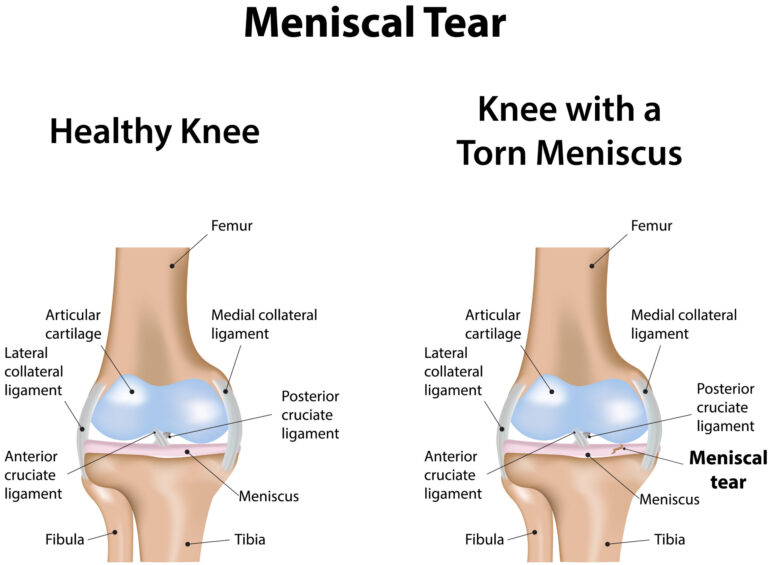Are you suffering from knee joint pain all of a sudden? It is time not to ignore it, thinking it is just a common paint due to age. Let’s be honest with ourselves. Many elderly patients tend to ignore knee pain, thinking it is just age-related. And, if you are in the age group of 30 – 54, you might neglect the knee pain, thinking it is just pain due to vitamin deficiency.

Time to rethink again? Sudden knee pain can be due to unusual ligament stretch or pain due to swelling of the ligament. It is important to know about the condition called meniscus tear so that you don’t miss out on the correct and accurate line of treatment. Here, we will provide you with all the correct information about the meniscus tear from the experts at the Specialty Care Clinics.
Meniscus Anatomy:
- The meniscus is a “wedge-shaped” cushion-like disc that sits between the thigh and leg bones. Each knee joint has two menisci, the outer (lateral) and the inner (medial).
- These menisci get their nutrients mainly from the synovial fluid (the fluid that is present in the knee joint).
- A meniscus has 3 main parts – a posterior horn, a body, and an anterior horn.
- The inner meniscus is oval and larger than the outer meniscus.
- The outer meniscus is more circular and has a greater surface area.
WHY THE MENISCUS IS IMPORTANT: FUNCTIONS OF THE MENISCUS
The meniscus is a flexible structure, and it acts as a “shock absorber” in the knee joint and protects the joint cartilage (the smooth surface at the ends of the thigh and leg bones that helps with walking).
They are also important in keeping the thigh bone fit to the leg bone. The meniscus helps to maintain joint coordination and maximizes the contact area between the tibia and femur.
WHAT CAUSES THE MENISCUS TO BURST OR TEAR?
A meniscus tear in young patients is mostly caused by twisting injury to the knee joint. In older persons, these are mostly due to age-related changes.
Abnormalities of the meniscus, such as an abnormal shape (discoid meniscus) or meniscus cysts, also increase the risk of injury to the meniscus. The inner meniscus is less mobile than the outer, so tearing of the inner meniscus is more common.
CAN ALL MENISCUS TEARS BE REPAIRED?
- Only 10-25% of the peripheral width of the meniscus has a blood supply.
- This peripheral zone is known as the “red zone”.
- There are no blood vessels in the inner one-third width of the meniscus. This is known as the “white-white zone”.
- Some blood vessels may be present between these two zones (red-white zone).
- The “red-red zone” tears, and some red-white zone tiers, have healing potential and can be repaired.
- Most of the tears are present in the “white-white zone” and cannot be repaired.
- All tears in the white-white zone and most tears in the red-white zone require removal of the torn part of the meniscus.
SIGNS AND SYMPTOMS:
- Pain– Pain and frequent swelling are common symptoms.
- Clicking sound– Often a torn piece of the meniscus gives a clicking sound and pain when the knee is entrapped in the flexion joint. This can happen while climbing or descending stairs or while sitting up.
- Locking of knees – Sometimes, the broken part gets stuck between the bones of the leg and thigh and can prevent the leg from straightening. This is called locking of the knee. A locked knee may need to be corrected by a doctor right away.
HOW IS MENISCAL TEAR TREATED?
- The diagnosis of a meniscal tear is confirmed by clinical examination and MRI.
- The new tier, major-tier, and outer red tier can be repaired.
- In meniscal repair, the broken parts are joined together with stitches.
- Older tears, inner-white-zone tears, degenerative tears, and complex tears usually have to be cut off and removed.
- All meniscus surgeries are keyhole surgeries and are performed with the help of an arthroscope (telescope).

Deal with meniscus tears the right way at Specialty Care Clinics. We provide the best expertise and care to treat the meniscus tear at an early stage. Recovery from a meniscus tear is very important to restore all the functions of the knee joint.
If you are suffering from meniscus tears and tired of various treatments, it’s time to switch your treatment with experts at Specialty Care Clinics today.

